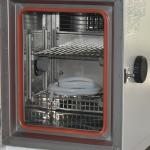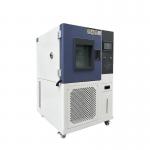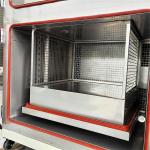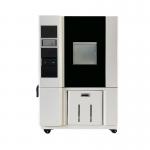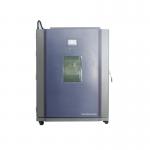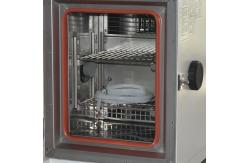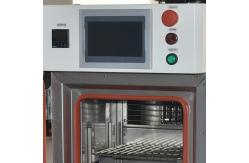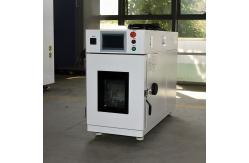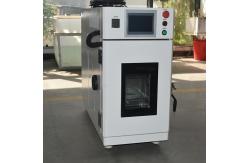1. IntroductionIn the vibrant and competitive landscape of the electronics and
electrical appliances industry, product performance and reliability
are of utmost significance. A custom small thermal chamber serves
as an indispensable asset for manufacturers, researchers, and
quality control teams. This specialized equipment is designed to
simulate a diverse range of thermal conditions, enabling
comprehensive testing of electronic components and electrical
appliances. By subjecting products to these simulated environments,
companies can ensure that their offerings can endure the real -
world thermal challenges they will encounter during operation. 2. Key Features2.1 Precise Temperature Control- Wide - ranging Temperature Adjustment: The custom small thermal chamber offers an extensive temperature
adjustment spectrum, typically spanning from - 40°C to 150°C. This
broad range allows for the simulation of frigid conditions, such as
those in cold - storage applications for certain electronic
components, as well as high - temperature scenarios, similar to
what electrical appliances might experience during continuous
operation or in hot - climate regions. For example, power - hungry
electronic devices like high - end gaming consoles can be tested
under elevated temperatures to assess their thermal management
capabilities.
- Exceptional Temperature Accuracy: Equipped with state - of - the - art temperature - control
algorithms and high - precision sensors, the chamber can maintain
the set temperature with an accuracy of ±0.3°C. This level of
precision is crucial for electronic components, as even minor
temperature variations can impact their electrical performance. For
instance, the capacitance of capacitors and the resistance of
resistors can change with temperature, and precise control helps in
accurately evaluating their performance within the desired
temperature range.
2.2 Compact and Portable Design- Space - saving Form Factor: Engineered with a compact and portable design, this thermal
chamber is ideal for laboratories with limited space, on - site
quality control inspections, or small - scale production
facilities. Its small footprint allows it to be easily placed on a
standard laboratory bench or transported to different testing
locations. This portability is especially beneficial for companies
that need to conduct thermal tests at various stages of the
production process or for research institutions that require a
flexible testing solution.
- User - friendly Operation: The chamber features an intuitive control panel, often with a
digital display and easy - to - use buttons or touch - screen
interface. Operators can effortlessly set complex temperature
profiles, including heating and cooling rates, hold times, and
thermal cycling sequences. Real - time temperature monitoring and
data logging are also available, providing users with valuable
insights into the testing process.
2.3 Uniform Temperature Distribution- Advanced Air Circulation Technology: To ensure a consistent thermal environment inside the chamber, it
is equipped with an advanced air - circulation system. This system
uses strategically placed fans and air ducts to create a uniform
temperature distribution throughout the test volume. Whether
testing small - sized electronic components like integrated
circuits or larger electrical appliances such as smart speakers,
the uniform temperature distribution ensures that all parts of the
test item are exposed to the same thermal conditions. This is
essential for obtaining accurate and reliable test results, as
temperature gradients can lead to inconsistent performance
evaluations.
2.4 Customizable Fixturing and Accessories- Product - specific Fixtures: The chamber can be customized with a variety of fixtures designed
to securely hold different types of electronic components and
electrical appliances. These fixtures are tailored to ensure
optimal heat transfer and proper positioning of the test items. For
example, specialized holders can be used to test printed circuit
boards (PCBs) in a vertical or horizontal orientation, depending on
the testing requirements. Additionally, fixtures can be designed to
accommodate different sizes and shapes of electrical appliances,
from small - scale kitchen appliances to larger household devices.
- Optional Accessories: There are several optional accessories available to enhance the
functionality of the thermal chamber. Humidity - control modules
can be added for applications that require combined thermal -
humidity testing, such as testing the performance of electronic
devices in humid tropical environments. Gas - injection systems can
also be integrated to simulate different atmospheric conditions,
which is useful for testing products that will be used in specific
industrial or outdoor settings.
3. Specifications| Internal Capacity | 150L | | Internal Dimensions(mm) | W500×H500×D600 | | Sample Limitations | l flammable, explosive, and volatile material testing and storage | | l Testing and keeping corrosive materials in storage | | l testing or keeping biological samples | | l Strong electromagnetic emission source specimens are tested and
stored. | | Temperature Range | -40°C~+150°C | | High temperature zone | +40°C/+150°C | | temperature range | | Low temperature zone | -40°C/0°C | | temperature range | | Temperature recovery time | ≤ 5 minutes (temperature changeover time: 30S) | | High and low temperature exposure | ≥30min | | time | | Temperature fluctuations | ±0.5℃ | | Temperature deviation | ±2.0°C | | Test weight | 5 kg (excluding heat source) | | Test environmental conditions. | Ambient temperature: 5 to 35°C | | Relative humidity ≤ 85% RH | | Measurement data is based on the air outlet | | Meet test standards. | | GB/T 2423.1-2001 Test A: Low temperature test method GB/T
2423.2-2001 Test B: High temperature test method | | GB/T 2423.22-2002 Test N: Temperature change test method Test Na
GJB 150.3-1986 High-temperature tests | | GJB 150.4-1986 Low temperature tests | | GJB 150.5-1986 Temperature shock tests | | Ext. Dimensions(mm) | W 1600×H 2150×D 1700 |
4. Benefits for the Electronics and Electrical Appliances Industry4.1 Enhanced Product Performance and Reliability- Comprehensive Testing: By subjecting electronic components and electrical appliances to
a wide range of thermal conditions in the custom small thermal
chamber, manufacturers can identify potential design flaws and
performance issues early in the development process. This allows
for timely design optimizations, resulting in products that are
more robust and reliable. For example, testing the heat -
dissipation capabilities of a laptop's cooling system in the
chamber can help in improving its long - term performance and
preventing overheating - related failures.
- Quality Assurance: The high - precision temperature control and uniform temperature
distribution ensure consistent and reliable test results. This
helps in maintaining strict quality - control standards, as
products that pass the thermal tests are more likely to meet or
exceed the performance requirements of end - users. In a market
where product quality is a key differentiator, this can
significantly enhance a company's reputation and market
competitiveness.
4.2 Cost - Efficiency- Reduced Field Failures: Thorough thermal testing in the chamber helps in reducing the
number of product failures in the field. Since electronic
components and electrical appliances are used in a wide variety of
applications, a single failure can lead to costly repairs,
replacements, or customer dissatisfaction. By identifying and
addressing potential thermal - related issues during the testing
phase, manufacturers can save on the costs associated with post -
production failures, including warranty claims and product recalls.
- Optimized R&D and Production Processes: The compact size and user - friendly operation of the chamber
enable quick and easy testing, which accelerates the R&D cycle.
Engineers can rapidly iterate on their designs, test new materials,
and optimize manufacturing processes. This not only reduces the
time to market for new products but also minimizes the cost of
R&D by eliminating the need for large - scale, expensive test
facilities for initial prototyping and testing.
4.3 Flexibility and Adaptability |
